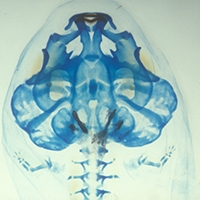Citation:
| 4.45 MB |
Date Published:
Jun 25Abstract:
Osteological evidence provides invaluable insights into patterns of amphibian biodiversity. In small montane streams of southeastern China, an endemic genus of salamanders (Pachytriton) displays remarkable aquatic specializations, many of which are reflected in skeletal morphology, but these specializations remain to be studied in an integrated perspective. Attempts to fully resolve the taxonomy within the genus also can benefit from knowledge of internal morphology. We present a detailed description of the adult skeleton of P. brevipes, P. inexpectatus and P. archospotus by analyzing both cleared-and-stained and radiographed specimens in a comparative framework. Compared to terrestrial and amphibious salamanders, the most distinctive osteological features of Pachytriton include a modified hyobranchial apparatus, a reduced frontosquamosal arch, and deep neural and haemal arches of the caudal vertebrae. The hyobranchial apparatus of P. archospotus is distinctly different from that of congeners and likely secondarily derived. Patterns of interspecific variation suggest that northeastern P. inexpectatus is more closely related to P. brevipes than it is to southwestern P. inexpectatus, thereby reinforcing results from earlier molecular phylogenetic analyses. We advocate assigning northeastern P. inexpectatus to P. brevipes.
Notes:
980FKTimes Cited:3Cited References Count:39






